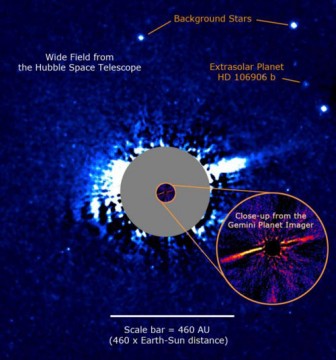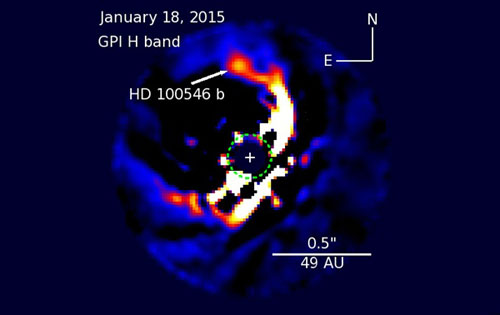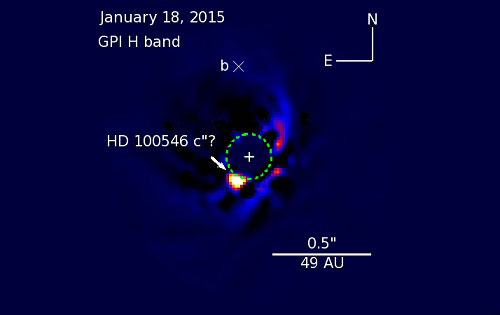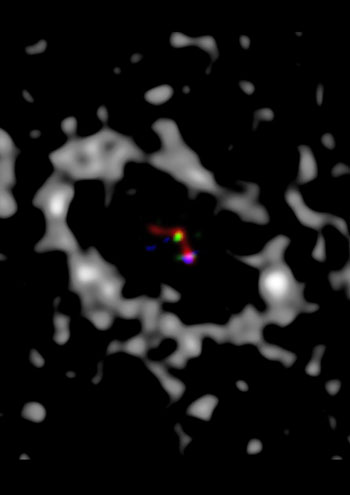Astronomers at the Extreme Solar Systems III conference announced several exciting results this week.
Warm and tranquil Hawai‘i is just the place to talk about exoplanets, those alien worlds that are often far from paradise. Scientists gathered this week in Waikoloa Beach to talk about “extreme solar systems,” from baby Jupiters to exiled planets. And now that scientists are moving from counting planets to characterizing them, the chatter centered on learning more about already known systems.
Planet in Exile
Back in 2013, Vanessa Bailey (University of Arizona) and colleagues discovered a giant planet about 11 times Jupiter’s mass and a lonely 650 a.u. from its parent star. That’s more than 10 times Pluto’s farthest point from the Sun.
The find initiated a debate: did the planet form where it was found, collapsing as a star would out of its natal gas cloud? Or did it form closer in, like planets normally do, before something flung it out to these far reaches?
Paul Kalas (University of California, Berkeley), Abhijith Rajan (Arizona State University), and colleagues have announced a definitive answer: this is a planet in exile.

P. Kalas / University of California, Berkeley
A GPI image of the system shows a nearly edge-on view of a ring of dust 50 a.u. wide around the star, much like the Kuiper Belt might look if we viewed our own solar system from outside. This comet-filled disk is lopsided in its outermost parts, fat on one side and skinny on the other. The lonely planet’s orbit is decidedly out of line with this disk.
“Planets don’t form outside the plane of the planetary system,” Kalas says. “This whole system has been recently disturbed by some violent gravitational interaction.”
But what that disturbance was is hard to say, Kalas adds. If it was a nearby star flying a little too close as it passed by, astronomers will need years of study to determine if a nearby star follows the right trajectory. Or the disturbing force could have come from a gravitational encounter with another as-yet undetected planet.
Baby Planet Pictures

Gemini Planet Imager
It wasn't so long ago that we’d never directly imaged an exoplanet. Now, new adaptive optics instruments are imaging young stars and their systems by the hundreds. And two new images, announced within weeks of each other, show for the first time planets caught in the act of forming.
The Gemini Planet Imager (GPI) is in the midst of surveying 600 young, nearby stars as part of its Exoplanet Survey (GPIES). It recently captured HD 100546, a massive star roughly 10 million years old and 320 light-years from Earth. The super-sharp image shows spiral arms sweeping through the star’s protoplanetary disk, roiled by the presence of at least one massive planet.

Gemini Planet Imager
That planet, HD 100546b, was expected from previous near-infrared observations, but with this direct image in hand, a team led by Thayne Currie (Subaru Telescope) pinned down its mass (3 to 4 times Jupiter's) and distance from its parent star (47 astronomical units, or a.u., the distance between Earth and the Sun). A hint of a second planet, more massive than the first but orbiting closer in at 14 a.u., glows at the end of another spiral arm. (If this second planet is real, its orbital motion should carry it behind the protoplanetary disk so that it disappears from observations in 2017.)
Delving deeper into the image, the team also examined HD 100546’s color. The planet’s emission is so red that it actually doesn’t match any atmospheric models — instead, Currie's team argues that we're seeing emission not from the planet itself, but from gas that’s feeding the planet.

Colored data: Stephanie Sallum; Greyscale image: sub-millimeter data published in Isella et al. 2014.
This result follows hot on the heels of Large Binocular Telescope and Magellan adaptive optics observations of a Jupiter-mass protoplanet orbiting the Sun-like star LkCa 15. The data show hot (10,000-degree) gas falling onto the forming planet, Stephanie Sallum (University of Arizona) and colleagues report in the November 19th Nature.
The two teams are the first to directly detect the gas that flows onto newborn planets — a glimpse of a growth spurt that’s far from understood. And these observations are only the beginning: future observations, such as with the Atacama Large Millimeter/submillimeter Array (ALMA), will continue to monitor these systems.
References:
Paul Kalas et al. "Direct imaging of an asymmetric debris disk in the HD 106906 planetary system." Astrophysical Journal, in press.
Thayne Currie et al. "Resolving the HD 100546 Protoplanetary System with the Gemini Planet Imager: Evidence for Multiple Forming, Accreting Planets." Astrophysical Journal Letters, in press.
Stephanie Sallum et al. "Accreting protoplanets in the LkCa 15 transition disk." (Full text.) Nature, 19 November 2015.
 0
0
Comments
You must be logged in to post a comment.